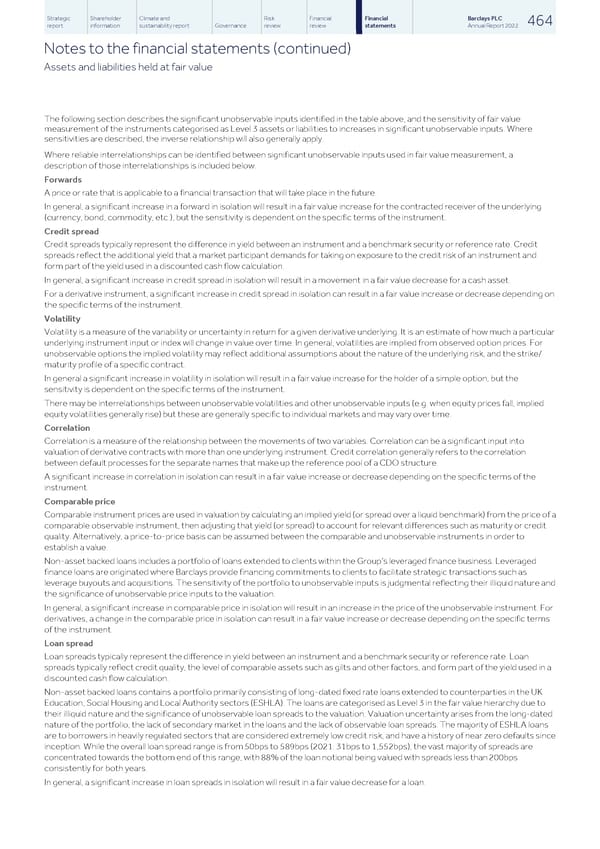Strategic Shareholder Climate and Risk Financial Financial Barclays PLC 464 report information sustainability report Governance review review statements Annual Report 2022 Notes to the financial statements (continued) Assets and liabilities held at fair value The following section describes the significant unobservable inputs identified in the table above, and the sensitivity of fair value measurement of the instruments categorised as Level 3 assets or liabilities to increases in significant unobservable inputs. Where sensitivities are described, the inverse relationship will also generally apply. Where reliable interrelationships can be identified between significant unobservable inputs used in fair value measurement, a description of those interrelationships is included below. Forwards A price or rate that is applicable to a financial transaction that will take place in the future. In general, a significant increase in a forward in isolation will result in a fair value increase for the contracted receiver of the underlying (currency, bond, commodity, etc.), but the sensitivity is dependent on the specific terms of the instrument. Credit spread Credit spreads typically represent the difference in yield between an instrument and a benchmark security or reference rate. Credit spreads reflect the additional yield that a market participant demands for taking on exposure to the credit risk of an instrument and form part of the yield used in a discounted cash flow calculation. In general, a significant increase in credit spread in isolation will result in a movement in a fair value decrease for a cash asset. For a derivative instrument, a significant increase in credit spread in isolation can result in a fair value increase or decrease depending on the specific terms of the instrument. Volatility Volatility is a measure of the variability or uncertainty in return for a given derivative underlying. It is an estimate of how much a particular underlying instrument input or index will change in value over time. In general, volatilities are implied from observed option prices. For unobservable options the implied volatility may reflect additional assumptions about the nature of the underlying risk, and the strike/ maturity profile of a specific contract. In general a significant increase in volatility in isolation will result in a fair value increase for the holder of a simple option, but the sensitivity is dependent on the specific terms of the instrument. There may be interrelationships between unobservable volatilities and other unobservable inputs (e.g. when equity prices fall, implied equity volatilities generally rise) but these are generally specific to individual markets and may vary over time. Correlation Correlation is a measure of the relationship between the movements of two variables. Correlation can be a significant input into valuation of derivative contracts with more than one underlying instrument. Credit correlation generally refers to the correlation between default processes for the separate names that make up the reference pool of a CDO structure. A significant increase in correlation in isolation can result in a fair value increase or decrease depending on the specific terms of the instrument. Comparable price Comparable instrument prices are used in valuation by calculating an implied yield (or spread over a liquid benchmark) from the price of a comparable observable instrument, then adjusting that yield (or spread) to account for relevant differences such as maturity or credit quality. Alternatively, a price-to-price basis can be assumed between the comparable and unobservable instruments in order to establish a value. Non-asset backed loans includes a portfolio of loans extended to clients within the Group’s leveraged finance business. Leveraged finance loans are originated where Barclays provide financing commitments to clients to facilitate strategic transactions such as leverage buyouts and acquisitions. The sensitivity of the portfolio to unobservable inputs is judgmental reflecting their illiquid nature and the significance of unobservable price inputs to the valuation. In general, a significant increase in comparable price in isolation will result in an increase in the price of the unobservable instrument. For derivatives, a change in the comparable price in isolation can result in a fair value increase or decrease depending on the specific terms of the instrument. Loan spread Loan spreads typically represent the difference in yield between an instrument and a benchmark security or reference rate. Loan spreads typically reflect credit quality, the level of comparable assets such as gilts and other factors, and form part of the yield used in a discounted cash flow calculation. Non-asset backed loans contains a portfolio primarily consisting of long-dated fixed rate loans extended to counterparties in the UK Education, Social Housing and Local Authority sectors (ESHLA). The loans are categorised as Level 3 in the fair value hierarchy due to their illiquid nature and the significance of unobservable loan spreads to the valuation. Valuation uncertainty arises from the long-dated nature of the portfolio, the lack of secondary market in the loans and the lack of observable loan spreads. The majority of ESHLA loans are to borrowers in heavily regulated sectors that are considered extremely low credit risk, and have a history of near zero defaults since inception. While the overall loan spread range is from 50bps to 589bps (2021: 31bps to 1,552bps), the vast majority of spreads are concentrated towards the bottom end of this range, with 88% of the loan notional being valued with spreads less than 200bps consistently for both years. In general, a significant increase in loan spreads in isolation will result in a fair value decrease for a loan.
 Barclays PLC - Annual Report - 2022 Page 465 Page 467
Barclays PLC - Annual Report - 2022 Page 465 Page 467